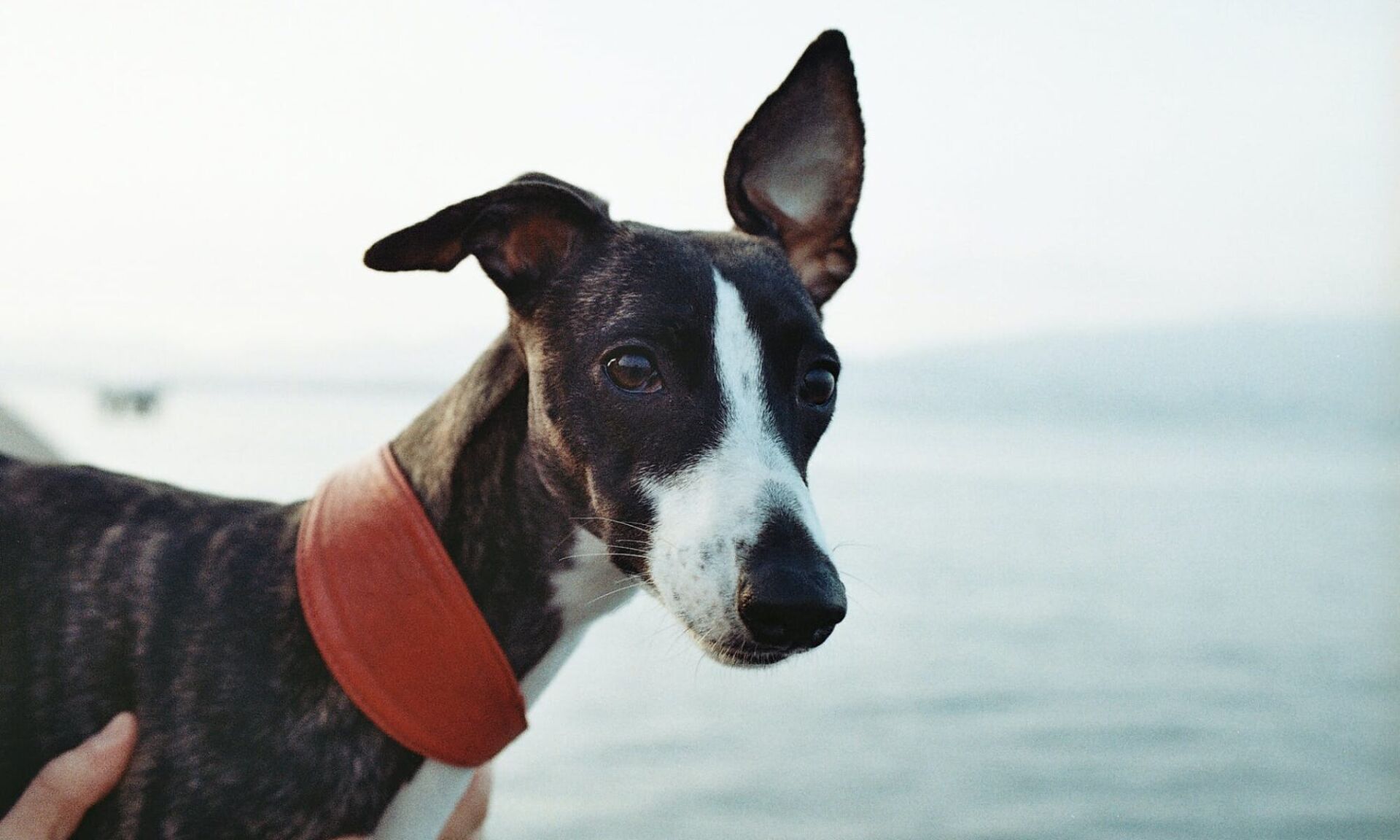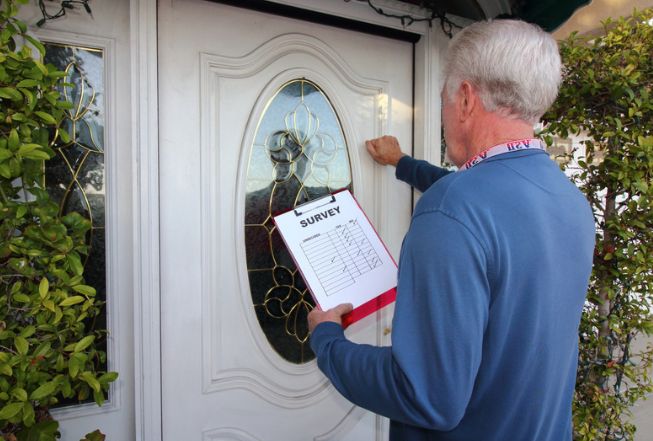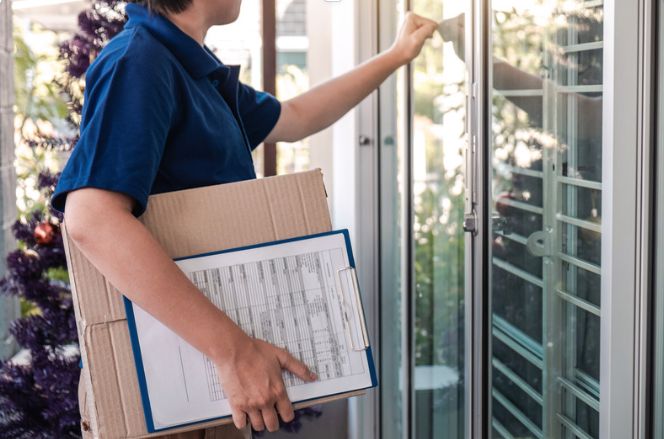I am afraid of snakes (ophidiophobia). The biologist in me finds snakes fascinating; however, when I encounter one, my emotions take over. I become trigger stacked. I live close to a nice trail system looping through a marsh. The marsh is home to tons of wildlife – including a variety of snakes. Fortunately for me, I don’t see snakes very often, but ….
Imagine if you will . . .
What now? While I could turn around, it will take longer to go back than it will to just keep going. So here I am – feeling panicky and stuck. Why didn’t I just turn around when I saw that first snake?! Ugh!!
YIKES!! Where did the rational adult go?
You know, the one who KNOWS that a little garter snake is not going to kill her. The one who finds snake anatomy absolutely fascinating. You know, the one who has never even had a bad encounter with a snake. The one who keeps saying that she just needs to get over this fear of snakes. Where did this irrational fear even come from?
Reason and common sense clearly lost the battle to fear and panic . . . and the fight or flight response took over. Fear and anxiety function in a very similar fashion in the canine brain. So, if you will, take a moment to insert a dog afraid of other dogs into this story. TI think you can imagine how what started out as a relaxing walk could quickly turn into a nightmare for your dog – and for you.
While you most surely understand this type of phobia, you may be wondering something. Why was it the innocent comment that sent me over the edge – and NOT the sight of the first or the second snake?
The answer is TRIGGER STACKING.
What is trigger stacking?
Trigger stacking is a phenomenon where a combination of multiple stressors (positive/negative, big/small) occur over a short period of time and culminate in an extreme reaction.
Every individual has a threshold beyond which they cannot cope or will have a reaction (e.g., scream, bark and lunge, bite, run away, cower in the fetal position, etc.).
Each time an individual encounters a stressor, a certain amount of cortisol (a stress hormone) is released. Different stressors will create different amounts of cortisol in different individuals. If an individual event creates enough cortisol to cross the reactivity threshold, the individual will react.
Stressors can also have an additive effect. It takes time for cortisol to dissipate from the blood stream. If an additional stressor occurs within that window, the cortisol that is released from the second event is added to the cortisol still in the system from the first event. This adds up, bringing the total level closer to threshold. So, if we encounter multiple stressors within a short period of time, they will have an additive effect and can cause the individual to go over threshold
.
How does trigger stacking affect fearful or reactive dogs?
We often talk about threshold when working with dogs who are overly sensitive and vigilant about their environment. More specifically we talk about the importance of keeping them under threshold. Why? Because when these dogs go over threshold, they respond with explosive actions. They lose all sense of reason, along with the ability to think. They cannot learn when they are in this kind of mindset.
Trigger stacking can be a major concern with these dogs. Let’s look at an example that will demonstrate how multiple stressors can affect a sensitive dog.
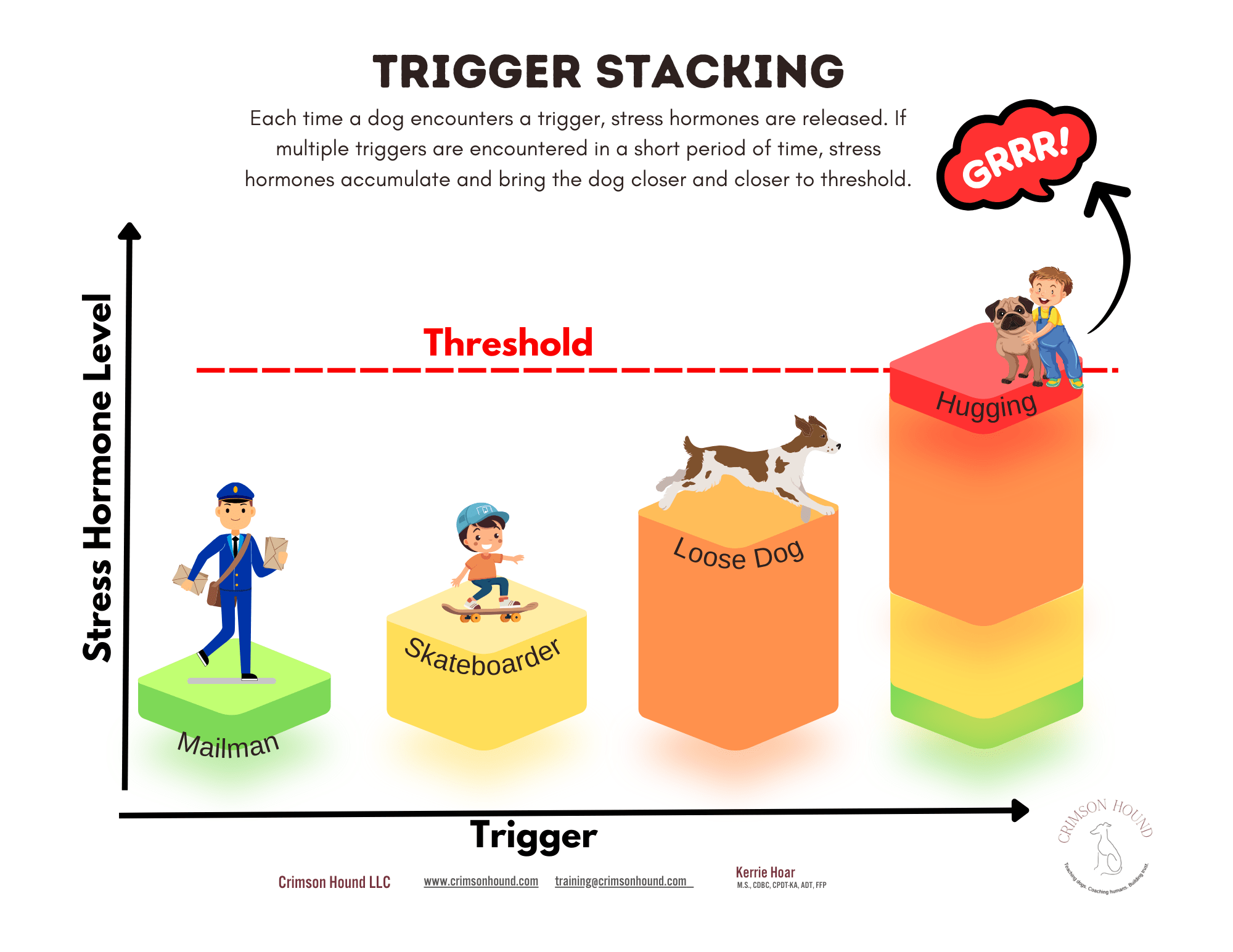

Scruffy and his owner are out for a morning walk. They come upon a woman pushing a baby stroller – something that is completely new to Scruffy. As the stroller passes by, Scruffy’s owner notices that Scruffy is yawning and ducking his head away from the stroller. He can’t possibly be tired ….

A few blocks later, a loose dog runs out of his yard and starts barking at Scruffy. Scruffy cowers, moves behind his owner and starts licking his lips. The loose dog’s owner calls him away. Since Scruffy didn’t growl or bark at the loose dog, his owner assumes that it wasn’t a big deal. They continue on their walk.
While Scruffy’s owner is at work, a pollster stops by the house, rings the bell and leaves a flyer on the door. Later, a delivery person rings the bell a couple of times and then leaves a package on the front step. Scruffy barks and growls each time the doorbell rings,
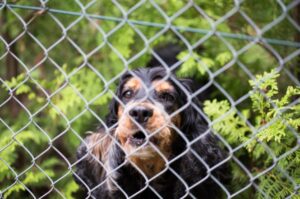
After work, the owner decides to take Scruffy out for another walk since he has been cooped up in the house all day. As they walk past the next door neighbor’s house, their old dog walks up to the fence. Suddenly, Scruffy explodes – barking and lunging at the dog. The owner is very upset and yells at Scruffy as he drags him away. “What the heck is wrong with you?! You see that dog every day! You never act like that!”
Trigger Stacking and the Ladder of Aggression
The graphic below shows the way that canine body language can advance from very subtle gestures to overly overt actions as a dog becomes more and more stressed and uncomfortable . . . often culminating in a bite if the stressor is not removed.
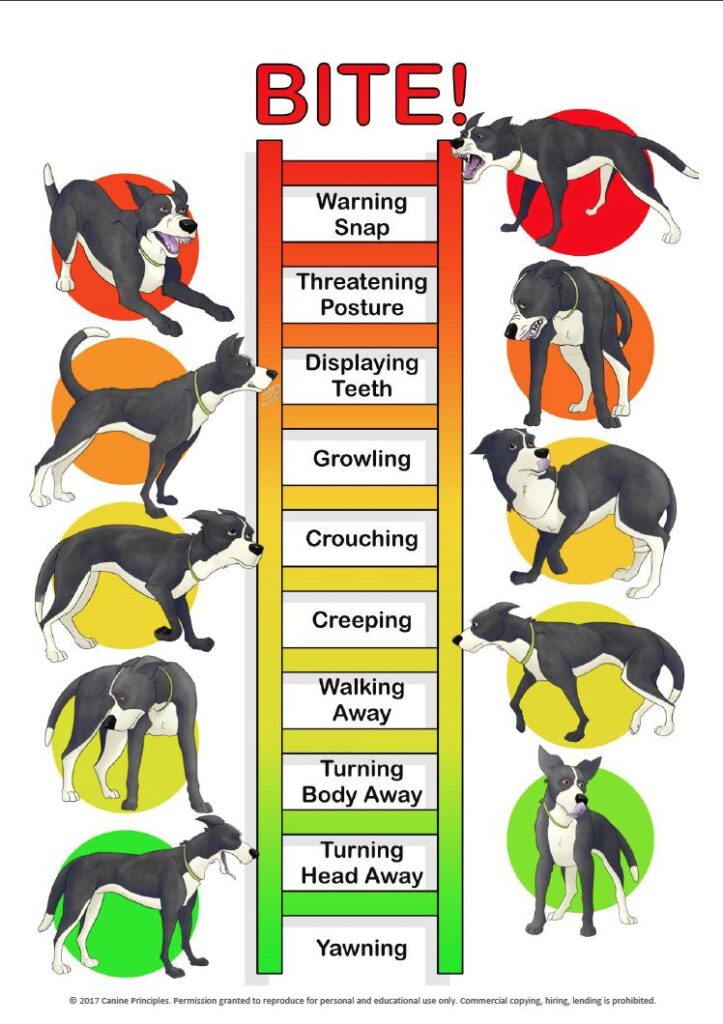
In addition to influencing how your dog reacts to stressors that he may encounter on a walk, trigger stacking is all too often the impetus behind a dog bite. Dogs do not bite “out of the blue”. Though the people involved may not recognize it, there is always a reason behind a bite. Dog bites are very often the result of someone not recognizing the body language that is indicative of the dog’s level of distress. We ingnore their signals until the dog advances to the level of using very overt level such as barking, growing, snarling, snapping and biting.
Let’s take a look at another example.
Jane called a dog trainer, clearly in distress. Her Chihuahua, Joey had just bitten her. According to Jane, she was simply trying to wipe off Joey’s paw when he growled and snapped at her. The bite caught her forearm and left a red mark. Jane could not understand why this happened since she wipes off Joey’s paws all the time. The bite just came “out of the blue”. During their first session, the trainer asked Jane to tell her everything she could remember about what Joey’s day looked like leading up to the bite.
See if you can you recognize some of the signals that indicate that Joey was experiencing trigger stacking.
- Joey had a veterinary appointment first thing in the morning. He doesn’t really like riding in the car, but since he is a little dog, Jane just lifts him up and pops him into the car. He sat still and pouted all the way to the vet – never giving Jane any eye contact.
- At the veterinarian’s office, Joey was faced with all of the sites and strong medicinal scents of the receiving area and crouched down in a corner. When they got to the exam room, Joey hid under a chair. He had his ears back and wouldn’t look at Jane.
- Joey’s vet was booked, so he saw a new vet and vet tech. He wouldn’t come out from under the chair, so Jane had to reach in and grab him. Since Joey wouldn’t sit still, the vet tech had to restrain him.
- After a physical exam during which his teeth, ears and eyes were checked and his temperature was taken, Joey got a couple of vaccinations.
- While they were in the office, it had started to rain. As Jane and Joey ran across the parking lot to their car, a big dog in another car barked and surprised them both.
Jane scooped Joey up and quickly popped him into the car before they both got soaked.
- On the way home, Jane stopped off at a store. She had to leave Joey in the car – something he hates. But the weather was nice and cool and she just needed a couple of items, so he would be fine.
- Joey started barking when Jane got out of the car and she could still hear him as she entered the store. When she came out, she could hear Joey barking as she approached the car. He was SO excited to see her. Silly boy, she was only gone for a few minutes.
- On the way home, a car pulled out in front of Jane, she had to slam on the brakes. Joey slid off the seat, and then decided to just stay curled up on the floor.
- When Jane and Joey arrived home, Joey walked through a couple of puddles on the way into the house. When they got inside, Jane set her bags down and grabbed a towel. She leaned over and took Joey’s leash off.
- When she picked up his front paws to dry them off, Joey gave a bit of a growl and lifted his lip, but he does that sometimes so she kept going. When she grabbed his back leg to start drying his paw, Joey growled, spun around and nipped her arm.
Can you see all of these little triggers slowly adding up and how Joey was giving subtle signals throughout the morning in an attempt to tell Jane that he was feeling uncomfortable and stressed?
This is a perfect example of how we humans miss the subtle communications that tell us when our dog is becoming increasingly stressed . . . and, how these stressors can have an additive effect on the dog. None of these stressors in and of itself was enough to cause a bite, but as they continued to stack, they moved Joey up the ladder of aggression. Unfortunately, we too often see only the end result and view it as a gross overreaction to a tiny incident.
What can we do to help our dogs?
- When Scruffy yawned as they passed the baby stroller and licked his lips when facing the loose dog, he was trying to tell his owner that he was uncomfortable with the situation. Be sure that you know how to recognize even the very subtle signs of stress in your dog. My blog, Dog Body Language: How to Speak Dog, is a great place to start. If you would like to take a deeper dive, check out my Canine Body Language for Pet Parents webinar. Norwegian dog trainer, Turid Rugaas, wrote a fantastic book on the subtleties of canine body language – On Talking Terms with Dogs: Calming Signals , Lili Chin has a very informative little book called Doggie Language that is filled with graphics and Tricia Hollingshead’s Listen to Me is filled with color photos and fantastic information . . .
- Mediate the intensity of the situation by controlling duration and distance with respect to your dog’s triggers. If you think that your dog might be getting trigger stacked, you can prevent outbursts by maximizing distance from triggers on your walk, go to a quiet place for a sniffari or even skip the walk and do some trick training, nosework or even a scatter feed in the yard instead.
Understanding Thresholds Diagram
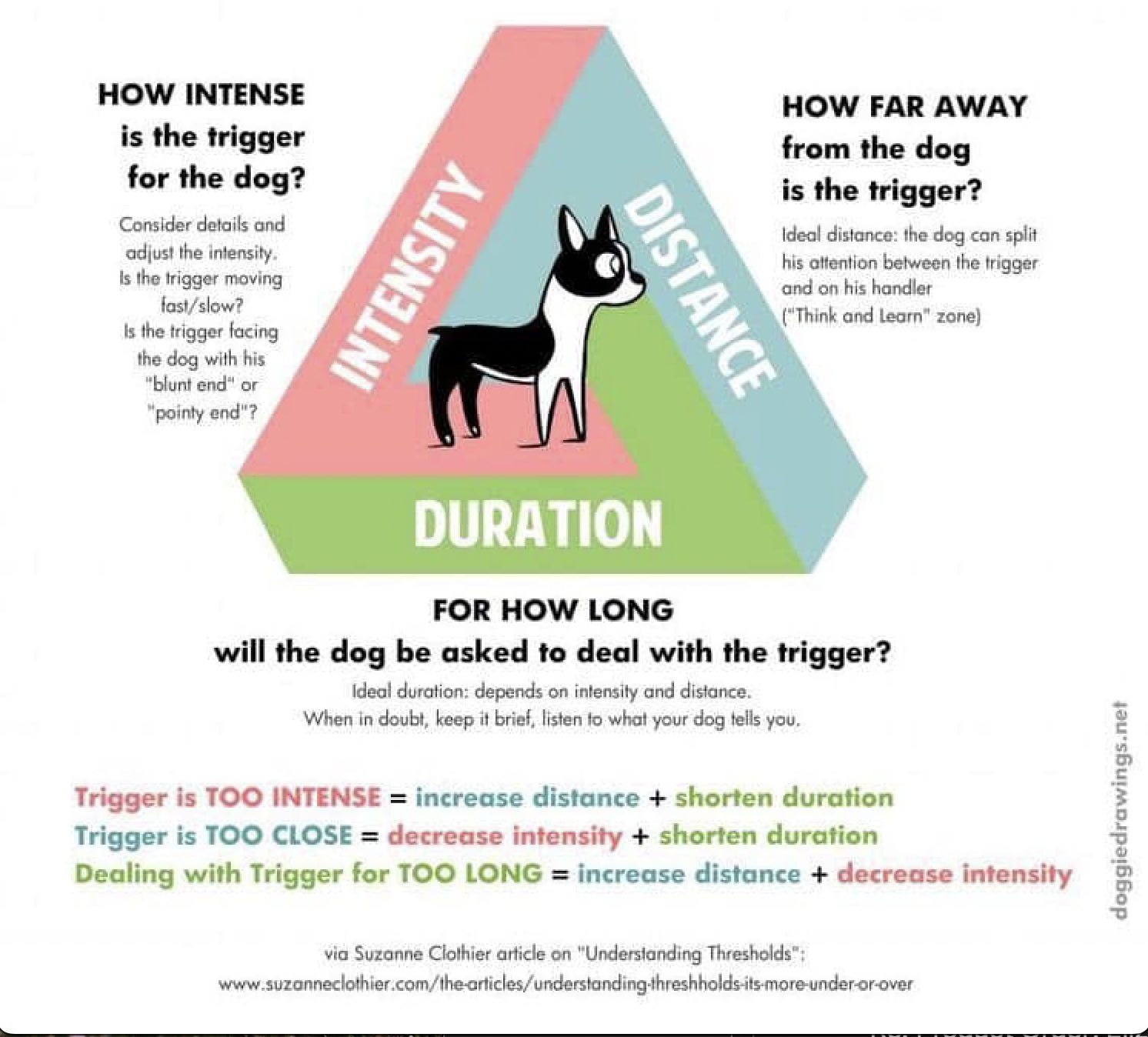
- Keep a journal of events that may be triggering to your dog and mediate the intensity of your dog’s encounters with his triggers in order to prevent over-threshold reactions and trigger stacking.
- Possible triggering events to be aware of:
- Children
- People ringing the doorbell
- Grooming, nail clipping or other types of husbandry
- A trip to the vet
- A new object – a stroller, wheelchair, holiday decoration, etc.
- A new location
- A familiar location that has changed – an empty park may be full of people, a change in season or weather has changed a familiar landscape
- A car ride
- Other dogs or people when out on a walk
- A new pet in the home
- Visitors in the home
- Losing a member of the household – moves/is out of town; a pet/person passed away
- A pet sitter or boarding
- Any change to his normal routine
- Pain or illness
- Time of day – light and shadows can effect visibility
- Loud noises – construction; thunder; fireworks; car backfiring
- Don’t push your dog’s boundaries until he is ready. If he is stressed by an event, take extra care with other possible triggers. Decrease intensity and duration as much as possible and increase distance as much as possible. There will be better days for reactivity training. Right now, your priority is self-care for your dog’s mental health.
- If you and/or your dog are struggling, contact a certified professional dog trainer whose training philosophy is grounded in positive reinforcement to help.
